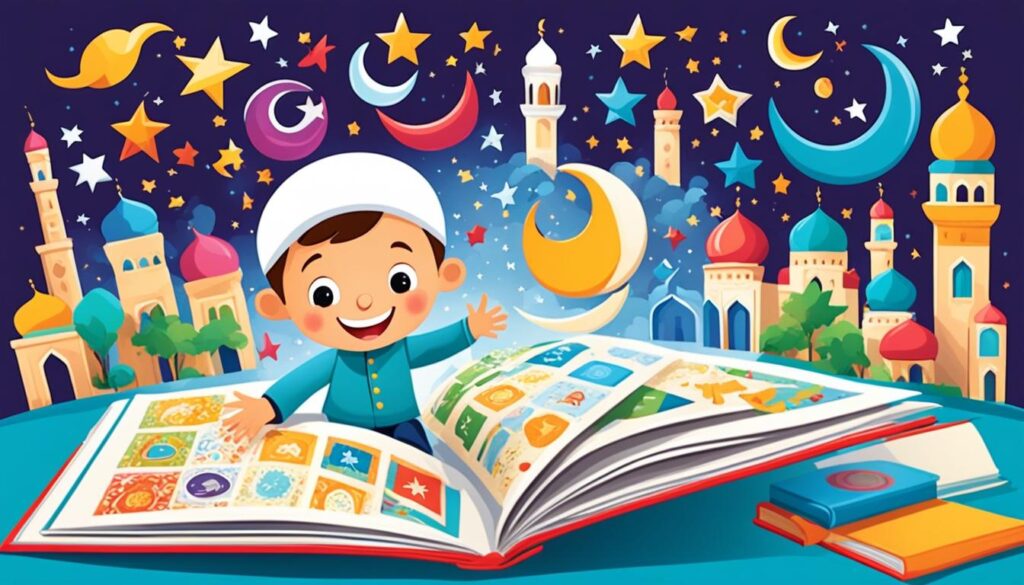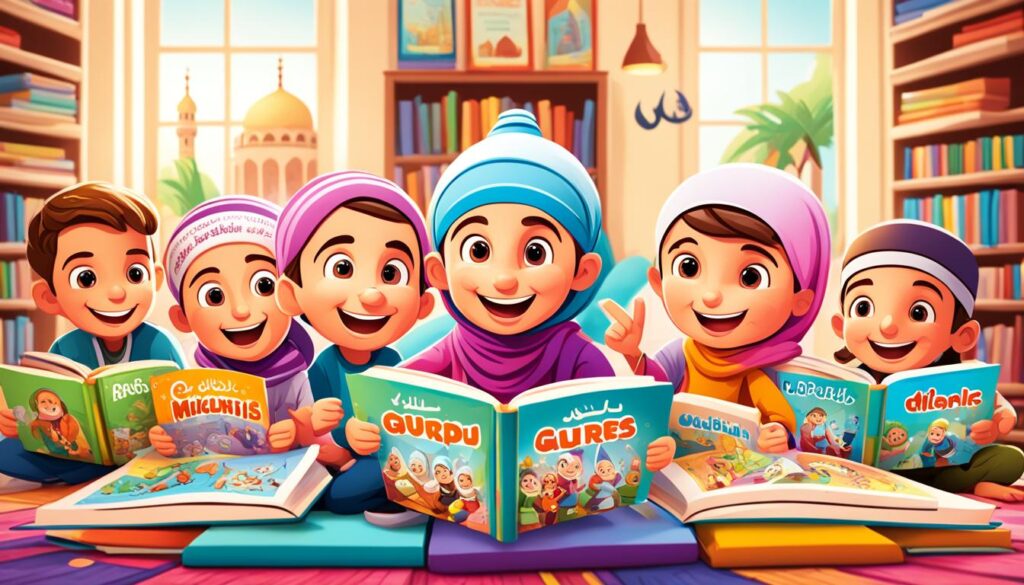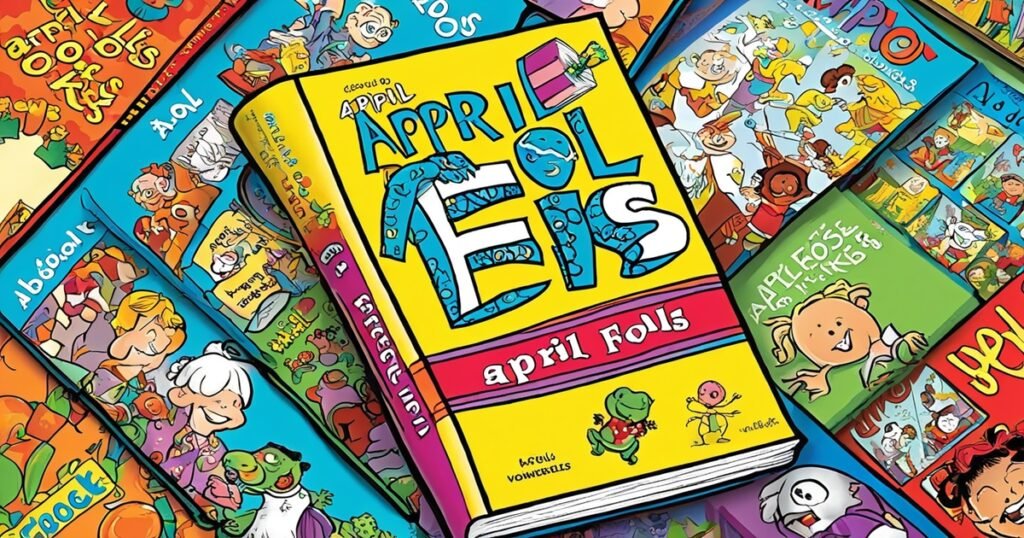Islamic literature provides vital and engaging tales for young readers, promoting cultural understanding and fostering a love of reading. The rich array of educational Islamic books for kids available today, authored by an ever-growing group of talented storytellers, reflects the vibrance and diversity of Muslim culture. Irrespective of whether the family follows Islamic traditions or seeks to appreciate the Islamic faith, these books feature stories that are relevant throughout the year.
From captivating adventure tales featuring Muslim protagonists to stories beautifully illustrating various Islamic festivals such as Ramadan and Eid, these educational Islamic reads make Islamic teachings readily accessible and enjoyable for children. Additionally, these books also serve as excellent educational resources for diverse classrooms aiming to encourage cultural appreciation and inclusivity.
Table of Contents
- Key Takeaways
- Embracing Cultural Diversity with Islamic Children’s Books
- The Role of Islamic Picture Books in Early Childhood Education
- Celebrating Muslim Traditions and Festivities in Stories
- Incorporating Islamic Teachings and Morals in Bedtime Stories
- Nurturing Empathy and Generosity Through Islamic Literature
- Exploring Muslim Children’s Literature for Toddlers and Preschoolers
- Engaging School-Age Readers with Islamic Chapter Books
- Selecting Books for Teaching About Islamic Beliefs and Practices
- Conclusion
- Source Links
Key Takeaways
- Islamic literature for kids offers engaging and informative narrative while introducing young readers to Muslim culture and traditions.
- These educational Islamic books act as a bridge, fostering understanding and cultural diversity.
- Stories are set against the vibrant backdrop of Islamic festivals and rituals, making them relatable and accessible for children.
- Whether for Muslim families seeking representation or classrooms desiring to foster cultural appreciation, Islamic books for children serve as valuable resources.
- These books are ideal for readers of all backgrounds, extending their understanding and appreciation of Muslim culture.
Embracing Cultural Diversity with Islamic Children’s Books
Increasingly, there is a spotlight on the dynamic genre of Islamic children’s books as they play a crucial role in fostering cultural diversity. These books feature Muslim protagonists and paint vibrant pictures of the culture and traditions of Islamic life. It’s an exciting transition that helps promote acceptance, inclusivity, and unity among children from various backgrounds.
The Significance of Representation in Children’s Literature
Representation in literature, especially in children’s books, is of vital importance. Introducing young readers to characters that reflect themselves and their experiences strengthens their identity and boosts their self-confidence. It plays a crucial role in fostering a sense of belonging and acceptance, and encourages an early appreciation for the diversity of the human experience.
Introducing Young Readers to Muslim Protagonists and Traditions
Islamic children’s books provide young readers with an authentic look into the lives and traditions of Muslim protagonists. These narratives, set against the backdrop of Islamic culture, are both educational and captivating, bringing to life relatable characters and storylines. Kids are given the unique opportunity to explore Islamic traditions through engaging stories about celebrations such as Eid, Ramadan, and the Hajj pilgrimage.
The goal of these books is not just to entertain, but to enlighten young minds and open a window onto the richness of Islamic culture and the diversity it brings to our shared global heritage.
The Role of Islamic Picture Books in Early Childhood Education
A decade ago, the integration of cultural diversity into early childhood education primarily revolved around world maps, flags, and traditional costumes. Today, however, educators understand the need for a more immersive and engaging approach. One such method is the use of stimulating picture books – specifically, Islamic picture books.
Illustrating Islamic Values Through Art and Storytelling
The art of storytelling aggrandized by captivating illustrations is an unprecedented approach to imbibe Islamic values in children. The colorful visuals stimulate the interest of young minds, making it easier for them to understand and absorb the rich teachings of Islam. Islamic picture books, with their engaging narratives and vibrant illustrations, are instrumental in promoting Islamic values among youngsters.
By presenting Islamic bedtime stories through appealing visuals and simple text, these picture books keep young minds engrossed while imparting essential teachings. Infusing the principles of Islam such as peace, love, and humility through fascinating stories, helps children connect with their faith on a deeper, more personal level. Such understanding at an early age aids in the cultivation of Islamic values and their practice in everyday life.

Promoting Multicultural Awareness with Visually Stimulating Content
One significant aspect of early childhood education is promoting multicultural awareness; helping children understand diversity and embrace inclusivity. From taking a trip to the market in the bustling streets of Istanbul to unfurling the essence of Ramadan, Islamic picture books offer a vibrant canvas representing diverse aspects of Islamic culture.
These books serve as an open window to the world of Islam, allowing children to explore and appreciate its rich culture and tradition. Not only are they an informative resource for children learning about Islam, but they also help children of non-Islamic backgrounds to foster a sense of cultural understanding and mutual respect – a much-needed trait in today’s multicultural society.
| Types of Islamic Picture Books | Description |
|---|---|
| Educational Books about Islamic Values | These books illustrate basic Islamic teachings and values, creating a solid understanding of the faith for young children. |
| Stories from the Quran | These are stories derived from the Quran, presented in a child-friendly manner with artistic illustrations. |
| Islamic Bedtime Stories | Short simple stories, often revolving around Islamic values, ideal for a soothing bedtime read. |
| Books about Islamic Festivals | Books that introduce children to the joyous celebrations like Eid, Ramadan, and Hajj, teaching them about Islamic traditions and practices. |
To conclude, Islamic picture books carry the ability to shape a child’s perspective towards Islam and its teachings, making them an invaluable resource in early childhood education. By encompassing Islamic values and promoting multicultural awareness, these books help in fostering a generation that appreciates diversity and treats it with the respect it deserves.
Celebrating Muslim Traditions and Festivities in Stories
For young readers, comprehending the essence of Islamic cultures and traditions can be made more enjoyable and impactful through engaging narratives and storybooks. Muslim traditions are best highlighted when celebrated in stories about Eid, Ramadan, and the Hajj pilgrimage for kids. These educational Islamic books make the Islamic festivals come alive, creating excitement while imparting valuable cultural knowledge.
Eid and Ramadan: Bringing Islamic Festivals to Life for Kids
Eid books for kids and Ramadan stories are a splendid way to engage young minds in the history and customs of these important Islamic festivals. While reading about the celebration of breaking the fast (Eid) at the end of Ramadan, kids can experience the joy and excitement that accompanies these festivities, learning the meaning behind different rituals, and the importance of principles such as forgiveness and charity.
Learning About Hajj and Other Pilgrimages Through Narratives
In addition to celebrating joyful festivals, the significant event of Hajj is another remarkable element of Islamic tradition that can be explored through storytelling. Narratives about the Hajj pilgrimage for kids can provide an understanding of the dedication, faith, and unity it represents in the Muslim community. Young readers follow along with the characters, learning about the remarkable journey taken by millions of Muslims from around the world, as they fulfill this significant pillar of Islam.
The table below provides a quick overview of the themes commonly explored in children’s books about Islamic festivals and traditions:
| Theme | Description |
|---|---|
| Eid Celebrations | Stories revolve around the joyous celebrations of Eid-ul-Fitr and Eid-al-Adha, emphasizing teachings about forgiveness, charity, and community. |
| Ramadan | Books focus on the observance of Ramadan, the importance of fasting, and the excitement of preparing for Eid after Ramadan. |
| Hajj Pilgrimage | Narratives provide insights into the experience of the Hajj pilgrimage, elaborating on rituals, the sense of unity, and significance in the Islamic faith. |
The beauty of these narratives lies in their ability to take complex concepts such as faith, devotion, and community, and simplify them into engaging stories for young minds to digest. Through these Islamic books, children can enjoy a unique and enlightening journey through Islamic festivals and traditions, fostering cultural understanding that goes beyond the ordinary.
Incorporating Islamic Teachings and Morals in Bedtime Stories
As a vital part of a child’s nighttime routine, bedtime stories often provide an intimate platform ideal for enhancing their understanding of their environment, experiences, and values. It is within these quiet, comforting moments that the beauty and depth of Islamic teachings can be seamlessly woven into captivating narratives, creating memorable moral stories for kids.

The enrichment of a child’s mental diet with enlightening snippets of Islamic children’s literature doesn’t only serve as a pathway to dreamland, but it also cultivates their moral compass. This integration employs a child’s natural inquisitiveness and their love for stories to impart deep-seated values, encouraging introspective moments that help shape their character and worldview.
Children are naturally drawn to the emotional undercurrents of stories, with the characters’ experiences often resonating with their own. By carefully integrating lessons from Islamic teachings into bedtime stories, children not only get to embark on thrilling adventures but also subtly learn about empathy, kindness, courage, and resilience – all core tenets of Islamic moral teachings.
“Stories are the creative conversion of life itself into a more powerful, clearer, more meaningful experience. They are the currency of human contact.” – Robert McKee
Moral Stories for Kids enriched with Islamic teachings serve as a trove of wisdom subtly disguised as entertainment. As the plots unfold and characters develop, children unwittingly absorb vital lessons that extend beyond the words on the page, lessons that guide their actions, thoughts, and attitudes.
Ultimately, the choice to fold Islamic teachings into bedtime stories not only enhances the narrative but also serves as a nurturing ground for the values we hold dear. The efficacy of this approach transforms bedtime into more than sleep-time preparation. It becomes a journey of growth, understanding, and spiritual enrichment for every child.
Nurturing Empathy and Generosity Through Islamic Literature
Books have always been a gateway to understanding the world and the various walks of life. When it comes to nurturing empathy, fostering kindness, and promoting the spirit of charity, Islamic literature for young readers shines a light on these values, significantly contributing to children’s social and emotional development. These books serve as a valuable tool in seeding the roots of compassion and altruism in the young minds, eventually developing socially responsible and kinder individuals.
Developing Social Responsibility Through Muslim Children’s Literature
Muslim books for children often weave life lessons into captivating narratives, highlighting the importance of understanding others and the quintessential Islamic principles of kindness and sharing. These stories aim at molding children’s innocence into a force for good, teaching them to empathize with those in different circumstances and take the initiative to help others. By resonating with the readers at an emotional level, Islamic stories for kids imbue them with a sense of social responsibility that stays with them as they grow, shaping their worldview and attitudes towards others.
Fostering Kindness and Charitable Acts in Young Hearts
Islamic literature is rich with tales of generosity and charitable acts, reflecting the core Islamic value of giving. Stories illustrating how kindness can make a difference serve as inspiration for young readers, sowing the seeds of compassion and generosity in their hearts. They encourage children to empathize with those in need, motivating them to partake in acts of kindness in their daily lives and cherish the joy of giving. This inevitably fosters a spirit of benevolence and charity in them, which is a cornerstone of the Islamic faith and a universal value for humanity at large.
Exploring Muslim Children’s Literature for Toddlers and Preschoolers
For toddlers and preschoolers, delving into the engaging world of Muslim children’s literature can serve as a delightful introduction to Islamic beliefs and cultural practices. These formative years are undisputedly crucial for implanting the seeds of early Islamic education, and hence, carefully curated books tailored to this young audience’s comprehension level can play an invaluable role.
The key to ensuring toddlers and preschoolers grasp the essentials of the faith lies in these impactful stories. They use simple, understandable language and vibrant, colorful illustrations to spark interest and foster understanding in the basics of Islam, thereby opening new horizons for these young learners to explore.
“Education is the most powerful weapon which you can use to change the world.” – Nelson Mandela
Even more critically, some of these books are designed distinctively as Muslim preschool books, which seamlessly integrate educational goals with the ethical teachings of Islam. By blending compelling storytelling with Islamic values, they can encourage empathy, tolerance, and awe for the beauty in diversity, cultivating a well-rounded perspective from a young age.
- Islamic Picture Books
- Introduction to Prophets and their Stories
- Fables with Islamic Messages
- Islamic Rhymes and Poems
- Biographies of Significant Islamic Figures
A solid foundation in matters of faith and practised virtues can influence a child’s worldview and attitudes throughout their life. Whether it’s a poetic rendition of a Quranic story, a vibrant retelling of Prophet’s life, or a heartwarming tale demonstrating the principles of love and compassion — the richness and diversity of this genre cater to every taste.
| Categories | Examples |
|---|---|
| Interactive Story Books | “My First Quran Storybook” |
| Rhymes & Poems | “Muslim Nursery Rhymes” |
| Prophet Stories | “The Story of the Holy Prophet Muhammad” |
| Eid Books | “Eid Mubarak: Precious Moments” |
| Fasting During Ramadan | “My First Ramadan” |
| Fables with Islamic Lessons | “Animal Tales from the Quran” |
In conclusion, providing toddlers and preschoolers with age-appropriate Muslim children’s literature is a wonderful, positive step towards raising thoughtful, inquisitive and ethically conscious individuals. The importance of their early Islamic education cannot be understated, as it paves the way for a well-rounded and balanced worldview.
Engaging School-Age Readers with Islamic Chapter Books
As children grow and their reading skills develop, Islamic chapter books take center stage, introducing them to more intricate narratives and complex characters. These books not only provide an engaging and enjoyable reading experience, but they also take on larger themes pertinent to older children such as identity, friendship, and resilience, all while preserving the essence of Islamic principles and culture.

With richly descriptive stories and relatable characters, Islamic chapter books equip young readers with the ability to navigate the complexities of life while anchoring them firmly in their cultural and religious roots. The ability of these books to seamlessly blend entertainment and education truly sets them apart.
In an age where digital distractions are abundant, engaging young readers is no small feat. Islamic chapter books employ a variety of strategies, such as action-oriented stories, mystery and suspense, and relatable characters, to capture the attention of school-age kids and foster a love for reading. Whether the story is about a group of friends navigating their way through school or a protagonist grappling with their identity in a multicultural society, these books reflect realities that young readers can identify with.
Thus, Islamic literature not only becomes a gateway for children to explore their culture and faith but also a powerful tool to foster empathy, broaden their worldviews, and build a strong sense of self.
| Islamic Chapter Books | Themes |
|---|---|
| Mystery at the Mosque | Mystery, Friendship, Islamic Values |
| Adventures of Ali | Journey, Courage, Islamic Teachings |
| My Big Fat Muslim School | School Life, Identity, Faith |
| Journey to Jannah | Adventure, Self-discovery, Islamic Principles |
| Bilal and Aisha: Heroes of Islam | Resilience, Islamic History, Perseverance |
Hence, the power of Islamic chapter books lies in their ability to hold a mirror up to young readers, showcasing characters and scenarios that resonate with their daily life while simultaneously nurturing their spiritual growth.
Selecting Books for Teaching About Islamic Beliefs and Practices
When it comes to teaching Islamic beliefs and practices, the selection of books plays a critical role in conveying accurate and authentic Islamic teachings. The ultimate goal is to present a true reflection of Islam that is respectful to the culture and enlightening to the reader.
There are a myriad of Islamic educational resources available that cater to different age groups and learning levels. However, focusing on authenticity and accuracy in Islamic literature can significantly enhance the learning experience, providing the reader with valuable insights into the fundamentals of the Muslim faith.
Criteria for Choosing Authentic and Accurate Islamic Books
Selecting the right Islamic books begins with understanding what to look for. Here are a few criteria to consider:
- The book should represent Islamic teachings correctly and respectfully, avoiding stereotypes and misconceptions.
- It should be written by an author with a sound understanding of Islam and its practices.
- The information presented should be well-researched and supported by credible sources.
Recommended Resources for Understanding Muslim Faith Fundamentals
For those seeking to delve deeper into the fundamentals of the Muslim faith, there are a number of recommended Islamic books that stand out for their comprehensive and clear explanations of Islamic beliefs and practices. Numerous authors and Islamic scholars have dedicated their work to crafting resources that are not only informative but also engaging, making the learning journey enjoyable and fruitful.
Here are some noteworthy titles to consider:
| Book Title | Author | Description |
|---|---|---|
| Understanding Islam | Frithjof Schuon | This book provides a comprehensive overview of Islam’s key teachings and practices, making it a great starting point for beginners. |
| A Journey through Islamic History | Yasminah Hashim | A well-presented historical journey encompassing the main events and figures of Islamic history. |
| Introduction to Islam | Matthew S. Gordon | A straightforward introduction to the faith, ideal for readers seeking a broader understanding of Islam. |
| The Holy Qur’an for School Children | Fisabilillah Organization Educational Department | An accessible rendition of Qur’an for young learners, incorporating clear explanations and engaging illustrations. |
Choosing the right Islamic books can significantly enhance the teaching and learning process of Islamic beliefs and practices. By focusing on authenticity and accuracy, parents and educators can provide a solid foundation for understanding the rich teachings of Islam.
Conclusion
In the dynamic and diverse world of children’s literature, Islamic books have marked a significant position. They have made substantial contributions towards fostering lifelong reading habits in young minds. These unique narratives, enriched with Islamic teachings, values, and culture, play a pivotal role in the development of children by offering a combination of education and enjoyment.
Encouraging Lifelong Reading and Learning with Islamic Children’s Books
Islamic children’s books offer a veritable treasure trove of engaging content that promotes learning with Islamic books. Exploring such literature opens the door to stimulating storylines, endearing characters, and valuable insights into Islamic beliefs and practices. It nurtures curiosity and an appreciation for the rich tapestry of Islamic tradition, effectively enriching young minds. Having sparked their interest, these books reinforce lifelong reading habits which in turn aid in the multifaceted development of young readers.
The Lasting Benefits of Inclusive Bookshelves for Young Readers
Inclusion in literature is a key factor in promoting cultural understanding and respect among children. The presence of varied reading material, particularly including Islamic literature for children, results in inclusive bookshelves which serve as mirrors and windows into our diverse world. Not only does this encourage a broader perspective, but it also helps young readers to develop an understanding and appreciation of different cultures and traditions. Such diversity in reading material underscores the benefits of Islamic literature, enriching the learning experiences and fostering a well-rounded development of young readers.
FAQ
What are some examples of educational Islamic books for kids?
There are many educational Islamic books for young readers ranging from Islamic picture books focusing on core values, stories highlighting significant Islamic festivals like Eid and Ramadan, and chapter books for older kids providing relatable narratives firmly rooted in Islamic traditions. They provide both engaging reads and valuable insights into Islamic teachings and culture.
How do Islamic children’s books embrace cultural diversity?
Islamic children’s books embrace cultural diversity by featuring Muslim protagonists and spotlighting Islamic traditions. Through these narratives, young readers get an opportunity to understand and appreciate Muslim culture, contributing to a more inclusive literary landscape and promoting mutual respect and understanding.
What role do Islamic picture books play in early childhood education?
Islamic picture books play a significant role in early childhood education by conveying Islamic practices and values through vibrant illustrations and storytelling. The blend of art and engaging narratives fosters visual learning, making Islamic teachings accessible and compelling for young children.
How are Muslim traditions and festivals represented in children’s literature?
Islamic children’s literature often includes stories set against the backdrop of key Islamic events and festivals like Eid, Ramadan, and the Hajj pilgrimage. These narratives bring these traditions and celebrations to life, giving kids a glimpse into these significant aspects of Muslim culture.
How can Islamic moral teachings be incorporated into bedtime stories?
Bedtime stories provide an intimate opportunity to introduce Islamic principles and ethical lessons. Characters in these stories often embody Islamic values, teaching kids about friendship, generosity, and moral conduct through engaging narratives that resonate with their experiences and emotions.
How does Islamic literature foster empathy and generosity in young readers?
Islamic literature often highlights the importance of empathy, generosity, and social responsibility, often through characters engaged in charitable acts. These narratives are designed to inspire children to empathize with those in need and to participate in acts of kindness.
Are there Islamic children’s books suitable for toddlers and preschoolers?
Yes, there are many Islamic children’s books tailored for toddlers and preschoolers. These books use simple language and colorful illustrations to introduce the basics of the Islamic faith and Muslim cultural practices, providing a foundation for early Islamic education.
How can I ensure I am selecting authentic and accurate books for teaching about Islamic beliefs?
When selecting books to teach about Islamic beliefs and practices, it is crucial to consider the authenticity and accuracy of the content. Look for books that are well-researched and written by authors with a clear understanding of Islam. In addition, recommended resources and books can provide comprehensive explanations of Islamic beliefs and practices.
How does including Islamic literature benefit a child’s learning and development?
Inclusion of Islamic literature on children’s bookshelves offers multiple benefits. It encourages lifelong reading habits, enriches their understanding, and promotes cultural diversity. Furthermore, by reading about Islamic values and teachings, they can foster empathy, generosity, and a well-rounded perspective, assisting their personal growth and understanding of the world.



